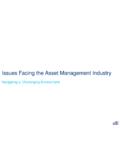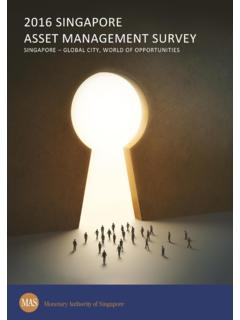Transcription of Asset vs. Facility Management Spot the Difference
1 1 | P a g e Asset vs. Facility Management Spot the Difference Comparative Analysis of Professional Identity and Functions Deyan Kavrakov FRICS, CIPS 2015 Asset Management has many roles and faces today. In modern business world, some are fascinated by its proliferation and complexity, similar to the admiration of a multitalented artist, who is all-in-one screenwriter, director and producer of the latest blockbuster. There are also others who view modern Asset Management as the mythical Hydra that has spread all over and hijacked various Management disciplines. Then, there are the Users and Clients who are.
2 Puzzled. The evolution of Asset Management (AM), Facility Management (FM) and Property Management (PM) throughout the past three decades has led to significant convergence and integration of their professional functions and business concepts. A concise comparison of AM vs. FM current identity will be useful to clients or users of Asset Management services, as well as to professionals managing multiple physical assets and focused on integrating the built environment, real estate, infrastructure, technology and people. Three major factors determine the differences between AM and FM: The Asset types to be managed; The organizational/corporate goals of the Asset s Owner/Investor; The assigned scope of responsibility.
3 First, let s highlight, that this analysis does not explore financial sector s wealth Management ; Management of financial assets, cash and investments instruments on behalf of their owner. Second, non-financial assets in any enterprise could be classified in two major categories according to their purpose of use: A. Assets that are used to carry out primary business functions (real estate, production machinery and equipment, plant facilities, tools, etc.) They are within the scope of responsibility of AM. B. Assets that are used in support business functions (buildings, transportation vehicles, workplace facilities, mobile devices, IT equipment etc.)
4 They are within the scope of responsibility of AM and FM. Third, physical/property assets are divided into two major types in accordance to their essential characteristic and function: 1. Immovable assets Vertical real estate (buildings) office, retail, industrial, logistic, residential, public, educational, health care, recreational, sports, multifunctional etc. Horizontal real estate (facilities) urban parks, playgrounds, sport facilities, recreation facilities, cemeteries, lakes etc. Infrastructure networks power, water, sewer, transport, communication, irrigation, defense etc.
5 (D. Albrice) 2 | P a g e 2. Movable assets Physical assets, which are not permanently attached to the immovable assets plant machinery, equipment, tools & instruments, vehicles, furnishings, electronics, IT devices etc. Once the playground is set up, let us focus at the concise comparison between AM and PM. differences Asset Manager (Physical Assets) For the Asset Manager the leading objective is maximum Return on Assets and Asset Utilization (rate) Asset Manager s scope of work are all assets utilized by both primary business and support business functions of company/organization Asset Manager's priority is to improve maintenance productivity and optimise equipment reliability as per Investor s production/primary business targets Asset Manager is focused on achieving Investor s profitability objectives while minimising assets capital expenditures (CAPEX)
6 Corporate social responsibility activities are out of AM s scope of work Facility Manager For the Facility Manager the leading objective is optimal work environment Facility Manager s scope of work are all assets which support the primary business of a company/organization Facility Manager's priority is to improve the User s primary business productivity and effectiveness Facility Manager is focused on End User/Occupier workplace needs and demands while optimising operational (OPEX) and capital expenditures (CAPEX). Over 90% of corporate social responsibility initiatives are managed by FM The hierarchy of objectives and tasks is one of the major differentiators between AM and FM.
7 A. Client s Agenda and Priorities The differences between the roles of AM and FM derive from the varying agendas of Investor/Owner and End User/Occupier, respectively their priorities. Asset Investors prioritize their goals as follows: 1. Value minimize Replacement Asset Value ratio (RAV), thus maximize Return on Net Assets (RONA) 2. Capital spending achieve optimal Capital Expenditure level while balancing Risk and Performance 3. Operations & Maintenance target optimal MTBF (mean time between failures) and maximize primary business process reliability 4. End user/Occupier maintain effective User feedback in order to achieve the first three objectives.
8 3 | P a g e Users prioritize their agenda in a significantly different order as compared to Investor: 1. End user/Occupant ensure that FM services are optimal cost/quality ratio and directed to supporting high productivity of primary business processes and end users 2. Operations & Maintenance operate and maintain the property/ Asset in support of the Occupier s core business activities and end users demand for continuous, effective and efficient workplace environment 3. Value preserve and maintain the value of the Asset /property based on whole lifecycle 4. Capital spending secure optimal level of capital spending in order to achieve the first three goals The hierarchy of objectives and tasks is the major differentiator between AM and FM.
9 In private sector, Asset Managers work for investors who own or lease real estate and assets for the cash flow from operating income and for the gain in value during their ownership term. Investors may consist of individuals, entrepreneurs, corporations, investment funds or a variety of trusts. In AM, the Client is the Investor, the User is the individual/organizational unit that utilizes the Asset to perform primary or support business function. Facility Managers work for the Occupants or Owners of real estate who own or lease their assets. They consist of private sector companies and individuals, public sector entities, central and local governments, NGOs.
10 In FM, the Client is the C-suite (strategic level); the Customer is the corporate/organization unit that specifies and orders the Facility services (tactical level); End User is the individual receiving Facility services: employee or visitor of buildings/facilities (operational level). B. Operations On operational level, Asset Managers prime interest on a daily basis is in enhancing effectiveness and efficiency of assets performance and production processes, by systematic maintenance Management and reliability engineering of physical assets. In AM, the complex equation of realizing value from assets while balancing their associated performance, risks and expenditures over their life cycles (J.)





